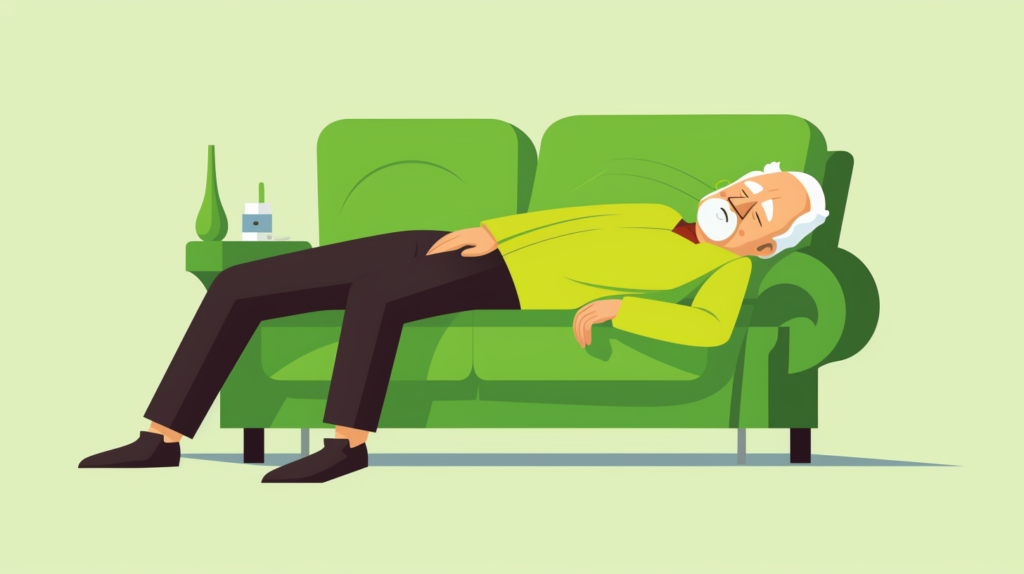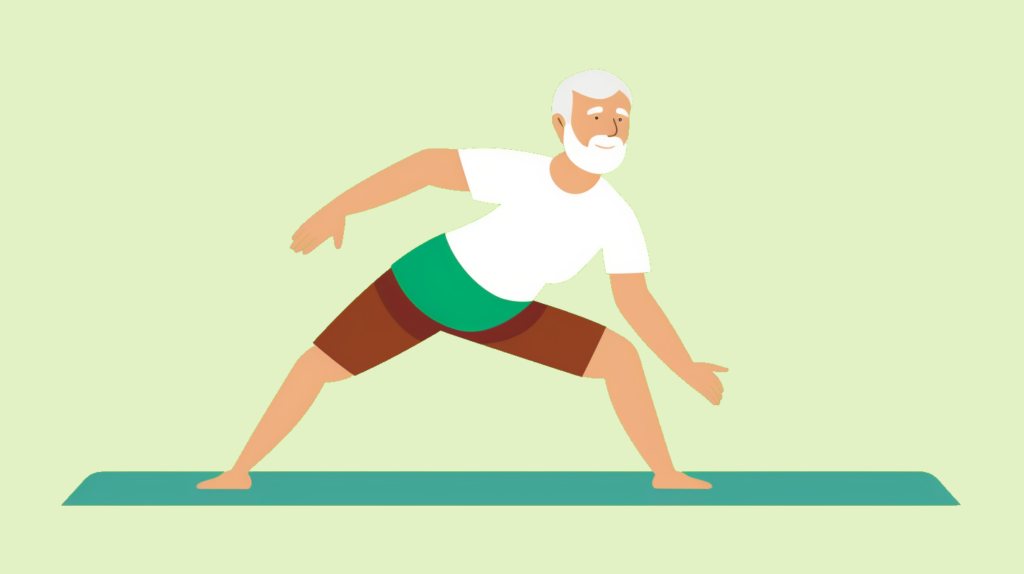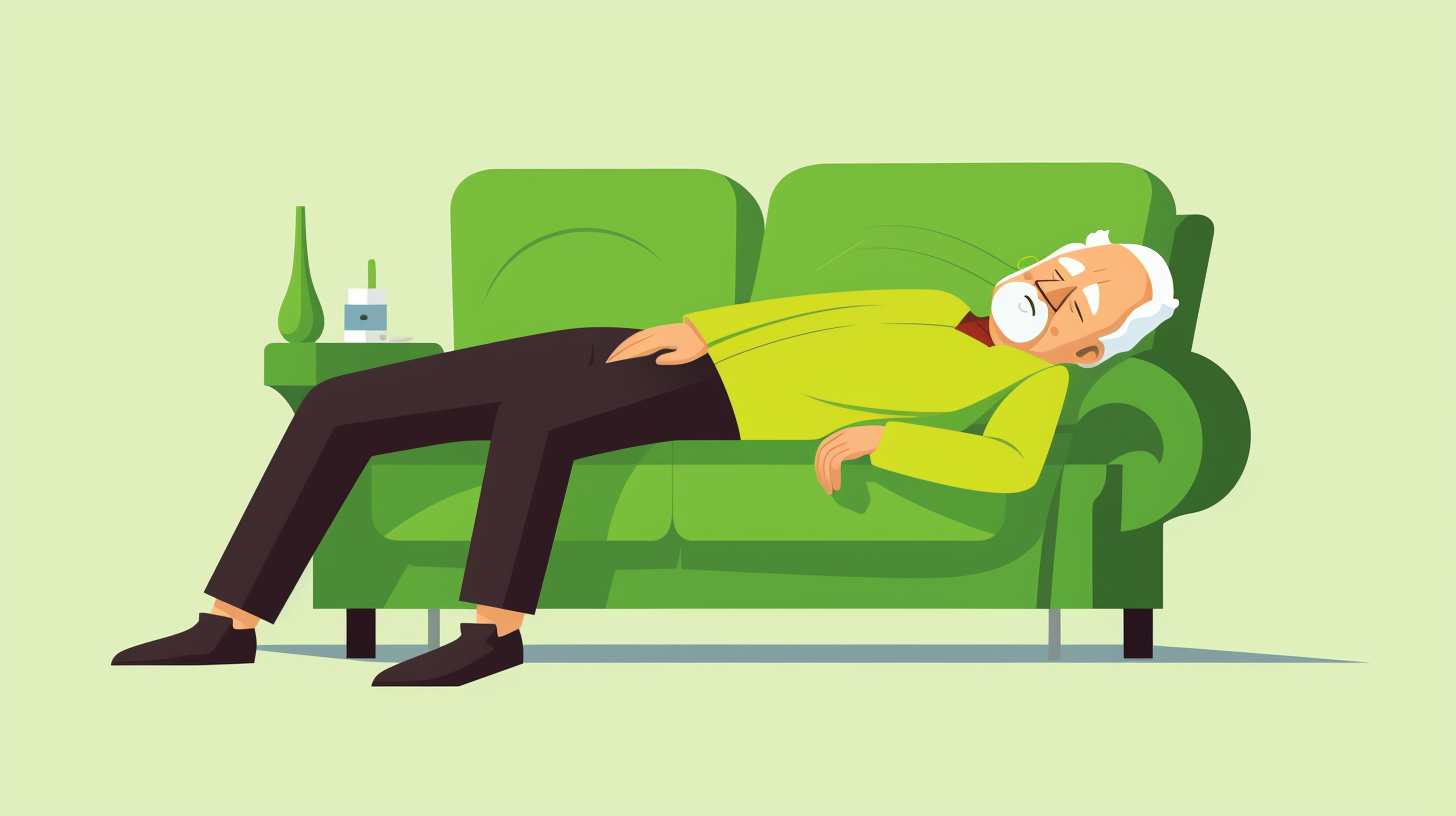An Overview of the Causes, Treatments, and Considerations of This Cryptic Condition
Imagine you’re tucked into bed, enveloped in the comfort of your bed, and expecting a restful sleep, but there’s an uninvited guest, a silent whisperer that disrupts your peaceful dreams—Central Sleep Apnea.
Often overshadowed by its more-talked-about sibling, obstructive sleep apnea, this condition is no less impactful on your well-being and can be even more elusive to pinpoint.
Central sleep apnea (CSA) isn’t about physical barriers making it hard for you to breathe; it’s a bit more complex.

Picture your brain as a conductor, orchestrating the rhythm of your breath as you sleep.
Sometimes, in the case of CSA, the conductor takes an unexpected pause, causing your body to forget its natural breathing pattern momentarily.
It’s a pause that can be as unsettling as it is mysterious.
Understanding Central Sleep Apnea can feel like solving a puzzle, but you’re not alone.
We’re here to guide you through the intricacies of this condition, offering you the foundational knowledge and potential next steps to reclaim your peaceful nights.
Unraveling the Mystery of Central Sleep Apnea
CSA, a type of sleep apnea distinct from the more familiar obstructive variety, is an intriguing condition that researchers are still investigating and exploring today.
Its rarity makes it hard to research and sometimes even more challenging for sleep medicine experts to diagnose.
While both central and obstructive sleep apnea disorders involve interruptions in breathing during slumber, they have distinct causes.
In the case of central apnea, it arises when the brain fails to control breathing while asleep effectively.
This form of sleep apnea, often induced by another medical condition, such as in patients with heart failure or neurological diseases, can disrupt your body’s automatic control center, leading to irregular breathing while asleep.
The Maestro Within: How Your Brain Orchestrates Every Breath
Imagine your brain as the maestro of a grand orchestra, where each musician plays a vital role in creating a harmonious melody.
In this symphony, your breath is crucial, helping supply all other orchestra members with oxygen while removing any harmful build-up in the room.
A specialized area within your brain, the medulla oblongata, is mainly responsible for conducting this intricate inhale and exhale dance, keeping things running smoothly.

It sends out rhythmic signals, like a conductor waving a baton, to the muscles involved in breathing—your diaphragm and the muscles around your lungs.
These signals tell them when to contract and expand, orchestrating the airflow in and out of your lungs.
Other regions, such as the pons and midbrain, also play a role. But the medulla oblongata is the head of operations.
It’s a seamless operation, so finely tuned you don’t have to think about it. It’s completely involuntary.
In fact, if you try to interrupt it by holding your breath, your body will eventually kick in and force you to exhale and take your next breath.
But what happens when the conductor misses a beat?
In the case of Central Sleep Apnea, it’s as if the medulla momentarily lowers its baton, causing a brief pause in the rhythm of your breathing.
It’s a hiccup in the symphony, a momentary lapse that can disrupt the quality of your sleep and overall well-being.
If you want to learn more about how your brain controls breathing, this article from Mindvalley and this study from the University of California San Francisco offer interesting insights.
But don’t worry.
Like any famous conductor, your brain is adaptable.
Treatments can help to reduce apnea episodes and help restore the natural rhythm of your breath quickly should one occur.
A Closer Look at Hyperventilation-Induced Central Sleep Apneas
Hyperventilation-induced Central Sleep Apnea is an interesting subtype within the CSA spectrum characterized by the periodic cessation or reduction of airflow despite the absence of any physical obstruction in the upper airways whenever you are over-breathing.
In this case, more is known about the cause of the episodes.
During rapid breathing during sleep, carbon dioxide levels in the blood drop.
This, in turn, causes a reduction in respiratory rate.
For the average person, this is entirely normal; after a slight reduction in respiratory rate, things return to normal.
But for the person living with hyperventilation-induced Central Sleep Apnea, the result is brief total pauses in all breathing.
Common triggers include having certain metabolic disorders, using specific medications, or living with chronic lung diseases—all factors that could alter standard ventilatory response mechanisms, thus triggering the onset of this peculiar form of CSA.
The Two Faces of Central Sleep Apnea: Primary and Treatment-Emergent
All Central Sleep Apnea syndromes can fit into one of two categories: primary Central Sleep Apneas and treatment-emergent Central Sleep Apneas.
Both affect your sleep quality but come about for different reasons and may require distinct approaches for management.
Primary Central Sleep Apnea occurs independently, often without an identifiable underlying cause.
Factors like heart and respiratory health can influence this form, but it’s generally considered a standalone issue.
Treatment-emergent Central Sleep Apnea, or Complex Sleep Apnea, is slightly different.
This form typically arises when you’re already undergoing Obstructive Sleep Apnea (OSA) treatment using Continuous Positive Airway Pressure (CPAP) therapy.
While CPAP machines are effective in keeping the airway open for OSA patients, they can sometimes lead to episodes of Central Sleep Apnea.
Essentially, your brain is adjusting to the new breathing pattern facilitated by the CPAP machine and may momentarily “forget” to maintain the rhythm.
This surprising development often baffles patients since it surfaces amidst efforts to improve their health through positive airway pressure therapy.
While both types can disrupt sleep and well-being, their treatment paths can differ.
Primary Central Sleep Apnea may require specialized devices like adaptive servo-ventilation (ASV) or medications to regulate breathing.
On the other hand, treatment-emergent Central Sleep Apnea often improves as your body becomes accustomed to CPAP therapy.
The Peculiarities of High-Altitude Sleep Apneas
High-altitude-induced CSA is an oddity in this two-group system.
It’s a distinct type triggered by reduced oxygen levels affecting normal respiratory mechanisms at elevated heights.

The body’s response varies among individuals, with some developing hallmark features associated with CSAs, such as periodic cessation or reduction in airflow.
Symptoms often resolve upon descent or over time as the body adjusts to a new altitude, distinguishing it from more persistent forms like primary and treatment-emergent CSAs.
However, those experiencing acute symptoms may require temporary interventions to help ease adaptation and support sleep quality and health throughout the adaptation period.
Mayo Clinic provides resources for further education and support regarding these conditions.
Fundamental Causes and Contributing Factors of CSA
As outlined in previous sections, there is rarely a single trigger or cause for Central Sleep Apnea (CSA).
As such, understanding these various risk factors and possible triggers vital to managing the disorder effectively.
Age and Genetics as Risk Factors for Central Sleep Apnea
Aging plays an undeniable role in the prevalence of sleep apnea, with older adults being more susceptible than their younger counterparts.
According to statistics reported by Drugwatch, as much as 32% of adults over 60 have sleep apnea.

This number is hard to gauge with total accuracy as so many cases of sleep apnea go unreported and undiagnosed.
Beyond just age, gender also influences one’s likelihood of developing CSA, with men typically at higher risk than women—at least until you reach the age of 60 or so.
In older populations, gender differences tend to even out.
Certain Heart Conditions as Triggers
Intriguingly enough, heart conditions such as congestive heart failure or atrial fibrillation can act as catalysts for triggering episodes of Central Sleep Apnea during restful periods.
These cardiac complications often lead to disruptions in standard breathing patterns due to disrupted circulatory function, making individuals prone to developing symptoms associated with CSA.
The Cheyne-Stokes Breathing Pattern
The Cheyne-Stokes breathing pattern is another critical factor contributing significantly toward the onset of nocturnal disturbances like Central Sleep Apnea, especially among patients with severe cardiac issues.
This abnormal respiratory rhythm is characterized by periodic changes in breath intensity followed by temporary cessation or reduction in overall respiration levels.
This creates the perfect environment for the emergence of disruptive sleeping disorders like CSA among affected individuals.
You can learn more about the Cheyne-Stokes breathing patterns in this helpful video by Respiratory Therapy Zone.
Medications & Other Risks
Many common medications increase the risk for OSA and CSA. These include:
- Opioids
- Benzodiazepines
- Beta-blockers
- Muscle Relaxants
- Antidepressants
This makes it crucial to discuss the potential side effects of any new medication regimen with your healthcare provider before embarking on a treatment course.

When starting any new medication, pay particular attention to your sleeping habits, energy, and moods.
If you suspect your medications might be causing or exacerbating sleep apnea symptoms, immediately contact your primary care provider or sleep specialist.
In most cases, there are alternative options that might result in fewer symptoms or decrease the severity of those you experience.
Why Treating CSA Matters for Your Health
CSA, just like OSA, has an extensive list of health concerns and symptoms if left untreated.
This isn’t just about excessive daytime drowsiness or difficulty concentrating—serious health risks are involved, particularly concerning your heart.
This happens because irregular breathing patterns in CSA lead to significant fluctuations in blood pressure and oxygen levels during sleep, which strains the cardiovascular system over time.
In this section, we’ll take a big-picture look at why seeking treatment for your sleep apnea symptoms is critical.
The Impact on Day-to-Day Life
Apart from physical health concerns, let’s not overlook how untreated CSA affects daily life.
Excessive daytime drowsiness due to fragmented nighttime sleep could pose safety risks when performing tasks such as driving or operating machinery.
It can also significantly impact your ability to perform your job or excel in school.
Potential Long-Term Health Consequences
Beyond immediate symptoms, the long-term consequences of leaving Central Sleep Apnea unaddressed include severe organ damage due to persistent low oxygen levels during episodes, which might harm organs, including the kidneys and liver.
Left unchecked, sleep apnea can even result in mood disorders such as depression or anxiety, according to Everyday Health.
Furthermore, emerging evidence links both obstructive and central forms of this disorder to the development and worsening of pre-existing metabolic syndrome, raising one’s chances for type II diabetes, high blood pressure, and other life-altering or threatening conditions.
Recognizing signs early and seeking appropriate medical attention promptly is crucial to preventing these adverse outcomes.
Remember, successful management starts by acknowledging the problem first and taking proactive steps to address the same under the guidance of healthcare professionals and sleep medicine specialists.
Thriving with Central Sleep Apnea: Your Guide to Symptom Management
Central Sleep Apnea (CSA) symptoms can present challenges. Fortunately, many lifestyle adjustments and treatments are available to help you find a new normal and restore your quality of life.
The critical element is continuing any recommended or prescribed treatment plan while communicating openly and often with your medical support team.
This may include consistent use of positive airway pressure devices or supplemental oxygen therapies, essential tools for improving quality of life by reducing daytime drowsiness and promoting better sleep patterns.
Outside of this core treatment approach, here are a few things you can do to support a healthy, active lifestyle and ensure you’re getting the most out of your nightly rest period.
Maintain a Regular Sleeping Schedule
A regular sleeping schedule is about more than just getting enough shut-eye. It is also integral to managing CSA symptoms.
Going to bed and rising at the same time daily, even on weekends, can help sync your body’s internal clock.

Sleep consistency promotes healthier brain activity during rest periods when controlled breathing needs to take center stage.
This makes it easier to fall asleep and lessens symptom severity.
Frequent Follow-ups with Your Healthcare Providers
We’ve mentioned this multiple times throughout this guide (and even have a dedicated guide to why follow-up care is essential to sleep apnea treatment), but it really is that important.
Routine check-ins are not just doctor appointments—they are lifelines.
These scheduled interactions allow healthcare providers to track progress, adjust treatments as needed, and answer any questions about living with CSA, including concerns regarding potential side effects from continuous positive airway pressure therapy.
Your healthcare provider serves as both a guide and companion throughout your journey towards improved symptom management, enhanced daytime alertness, and minimized discomfort.
Lifestyle Modifications: Small Steps Towards Better Health
Beyond medical intervention, lifestyle modifications also play a crucial role in coping with Central Sleep Apnea.
Maintaining a healthy weight through a balanced diet and regular exercise can often alleviate the severity of your sleep apnea symptoms by reducing strain on respiratory muscles involved in the breathing process during slumber.

Avoiding alcohol and smoking—especially in the evenings—can also improve the stability of your natural breathing patterns and should be considered seriously.
Remember, every small step counts towards achieving better health outcomes.
Frequently Asked Questions (FAQs) About Central Sleep Apnea
Can an otherwise healthy person have Central Sleep Apnea?
Yes. People with no pre-existing conditions can develop Central Sleep Apnea. However, it’s more common in older people with certain medical conditions or those on specific medications.
Can you live a normal life with Central Sleep Apnea?
Absolutely. With proper diagnosis and treatment, including lifestyle modifications and prescribed devices, one can lead a normal life despite having Central Sleep Apnea.
Can anything be done to treat Central Sleep Apnea?
Yes! Treatment options range from positive airway pressure therapies to medication and lifestyle changes. All of these can significantly reduce symptoms and improve quality of life.
Will PAP therapy help with symptoms of Central Sleep Apnea?
Continuous positive airway pressure (CPAP) therapy is often used as an effective treatment method for both primary and complex/treatment-emergent forms of Central Sleep Apnea.
How quickly can Central Sleep Apnea develop?
For some, CSA develops slowly over time. But for others, especially those with certain medical conditions, it can emerge relatively quickly over a period of weeks or months.
What tests are used to diagnose Central Sleep Apnea?
Diagnosing CSA may involve undergoing a physical exam, a sleep study test (polysomnography), and recording your breathing and heart rate patterns overnight. This data helps identify any apnea events.
For more on what to expect when diagnosing sleep apnea, consult our guides on at-home sleep apnea tests and lab-based sleep studies.
Can you die from untreated severe Central Sleep Apnea?
Though rare, there is a risk of death in those with severe, untreated CSA. This most often occurs from added complications, such as heart failure or stroke resulting from oxygen deprivation to the brain.
Conclusion
Unraveling the intricacies of Central Sleep Apnea takes patience, but knowledge is power.
While triggers range from medical conditions to altitude changes, this complex disorder is highly treatable through consistent use of recommended therapies like CPAP and lifestyle adjustments.
Though CSA presents challenges, you can find a new normal through open communication with healthcare providers and commitment to treatment.
Small steps like schedule consistency, diet improvements, and frequent medical check-ins make a big difference.
At CPAP Supply, Canada’s leading online CPAP store in customer satisfaction, we understand the obstacles of CSA and want to help. Our team of seasoned specialists can walk you through equipment options to create a CPAP setup that matches your needs and budget.
Reach out today to start a journey towards refreshed awakenings. With the right plan, you can outmaneuver CSA and reclaim restful nights.

